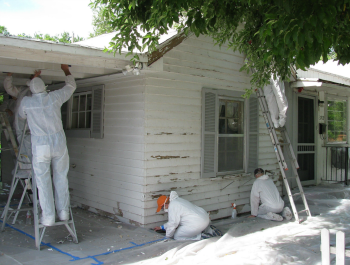Image

Lesley Krone, Community Engagement Consultant, NeighborWorks Boise
Challenge: For more than three decades, NeighborWorks Boise has painted thousands of houses owned by low-income, senior or disabled residents. But new EPA lead paint regulations limited our ability to safely prep homes that were built prior to 1978, and we were forced to turn away many homeowners.
NeighborWorks Boise has organized the community building event Paint the Town for 34 years. The program coordinates teams of volunteers who paint homes for elderly and disabled residents who do not have the financial or physical means to do it themselves. This program also revitalizes the neighborhoods by increasing property values, improving distressed properties and building pride among neighbors. It has been a highly-visible tradition helping thousands of homeowners, one that garners great support and awareness within the community.
But when new EPA lead paint regulations went into effect, we were blocked from painting any homes built before 1978 due to the potential presence of lead paint and the risks involved in prepping the houses for repainting. Boise has a large stock of pre-1978 homes, and we were forced to turn away many Paint the Town applicants, some in urgent need of our help.
So in 2015, NeighborWorks Boise partnered with a local environmental company, Torf Environmental Management, which conducts training for lead-certified renovators. They were eager and willing to help us with this problem and to spread awareness about lead safety.
“Paint the Town volunteers are helping maintain our neediest homes and protecting our friends and neighbors from exposure to poisonous lead,” said Torf Environmental Management CEO Mark Torf.
We conducted thorough lead testing of the homes; the company donated its time to train volunteers in proper lead paint stabilization and provided on-site support as volunteers conducted the work. The training included information about safety, EPA regulations, how to prepare for the work, containing the dust during the work and cleaning up and disposal of materials. We were able to recruit some amazing teams to suit up and prep these homes so that everything was safe for the volunteer teams to begin painting. We also received cooperation from the paint industry, which provided supplies needed to do the work, such as masks, suits, paint scrapers and plastic sheeting to line the house.
 In the first year of our partnership in 2015, approximately 20 volunteers received lead paint training and prepped five homes with lead-safe practices. These homes would have been turned away from our program if we had not partnered with this company, even though they were the homes with the most need for repainting.
In the first year of our partnership in 2015, approximately 20 volunteers received lead paint training and prepped five homes with lead-safe practices. These homes would have been turned away from our program if we had not partnered with this company, even though they were the homes with the most need for repainting.For our 2016 event, we simplified the training process with a shorter training session prior to the work and additional on-site training at each project location. We also improved scheduling the work to have a morning crew and afternoon crew at the same location to reduce the time needed for setup and cleanup if we could complete a project in one day. This also limits the time each volunteer spends working, since it can become tiring to conduct the work for long stretches.
In order to consider potential projects, we have an extensive selection process for Paint the Town. The first step is a homeowner application, where residents must indicate whether their home was built before 1978. Once finalists are chosen by the selection committee, homes are evaluated by a professional painter and residents are interviewed by a member of the committee. The evaluator will test the paint on the home with an instant lead test kit, which is donated by a corporate sponsor. If a home is confirmed to have lead paint, we then use a professional lead testing agency to indicate the locations of the lead. The agency provides pictures with instructions on exactly where the lead paint is and their recommendations on how to proceed. We also have this company test some homes that initially tested negative with the kits to confirm the home is lead-free and safe for volunteers. Based on all the information gathered, the selection committee makes its final decision on the recipients for the year.
By the second year of this partnership we had learned a lot. One main lesson is that anything is possible when you reach out to community members and find people who are passionate about your cause. Finding the right kind of volunteer is also key. Some volunteers were concerned about the risks, but once they were given lead paint safety training, they were more aware of actual risk level and were able to see how they could provide an incredibly valuable service for the homeowners.
We also discovered that professional lead paint testing was vital -- and expensive. But by explaining this to our partners we were able to get significant discounts. Working with a community partner is key to many elements of the project, especially when it comes to delivering efficient and comprehensive volunteer training.
This hasn’t been easy work, but our community is caring and willing to support its neighbors if they are given the tools and training to do so. Boise’s stock of pre-1978 homes is vast, but if we continue to stabilize five homes every year, we can eventually eliminate this dangerous problem.

